Today Current Affairs: 21st April 2022 for UPSC IAS exams, State PSC exams, SSC CGL, State SSC, RRB, Railways, Banking Exam & IBPS, etc
Table of Contents
Colombo Security Conclave Virtual Conference:

The Colombo Security Conclave Virtual Conference on Sharing of experiences in investigation of terrorism cases was organised by the National Investigation Agency of India on 19 April 2022.
- Panellists and participants from India, Maldives, Mauritius, Sri Lanka and Bangladesh participated in the virtual conference.
- The Colombo Security Conclave is a grouping of India, Sri Lanka, the Maldives and Mauritius.
- The fifth meeting of national security advisers of the Colombo Security Conclave was held in the Maldives on March 9 and 10, 2022.
Aurora Glow Observed Above Iceland:
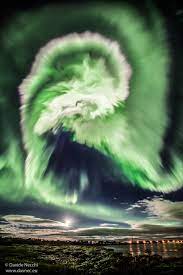
Stunning aurora glow was recently observed above Iceland after a ‘dead’ sunspot erupted.
- An Aurora is a display of light in the sky predominantly seen in the high latitude regions (Arctic and Antarctic). It is also known as a Polar light.
- There are two types- the aurora borealis and aurora australis – often called the northern lights and southern lights.
- They commonly occur at high northern and southern latitudes, less frequent at mid-latitudes, and seldom seen near the equator.
- While usually a milky greenish color, auroras can also show red, blue, violet, pink, and white.
- These colors appear in a variety of continuously changing shapes.
- Auroras are a spectacular sign that our planet is electrically connected to the Sun.
- These light shows are provoked by energy from the Sun and fueled by electrically charged particles trapped in Earth’s magnetic field.
- The typical aurora is caused by collisions between fast-moving electrons from space with the oxygen and nitrogen in Earth’s upper atmosphere.
- The electrons—which come from the Earth’s magnetosphere, the region of space controlled by Earth’s magnetic field —transfer their energy to the oxygen and nitrogen atoms and molecules, making them “excited”.
- As the gases return to their normal state, they emit photons, small bursts of energy in the form of light.
- When a large number of electrons come from the magnetosphere to bombard the atmosphere, the oxygen and nitrogen can emit enough light for the eye to detect, giving us beautiful auroral displays.
- They origin at altitudes of 100 to more than 400 km.
- The color of the aurora depends on which gas — oxygen or nitrogen — is being excited by the electrons, and on how excited it becomes.
- The color also depends upon how fast the electrons are moving, or how much energy they have at the time of their collisions.
- High energy electrons cause oxygen to emit green light (the most familiar color of the aurora), while low energy electrons cause a red light. Nitrogen generally gives off a blue light.
- The blending of these colors can also lead to purples, pinks, and whites.
- The oxygen and nitrogen also emit ultraviolet light, which can be detected by special cameras on satellites.
What Is The Opec+?
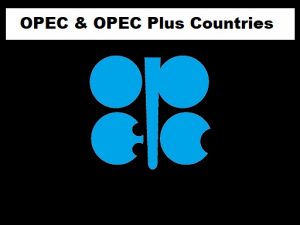
Russian President Vladimir Putin and Saudi Crown Prince Mohammed bin Salman gave a “positive assessment” to their cooperation on the OPEC+ producers group to stabilize the world oil market.
- Saudi Arabia and other major Persian Gulf oil producers have so far resisted U.S. calls to increase output as prices have surged amid the crisis in Ukraine and concerns about possible sanctions on Russian exports.
- So, measures such as these are necessary to set things right.
- Opec+ refers to the alliance of crude producers, who have been undertaking corrections in supply in the oil markets since 2017.
- OPEC plus countries include Azerbaijan, Bahrain, Brunei, Kazakhstan, Malaysia, Mexico, Oman, Russia, South Sudan and Sudan.
What is OPEC?
- The Organization of the Petroleum Exporting Countries (OPEC) was founded in Baghdad, Iraq, with the signing of an agreement in September 1960 by five countries namely Islamic Republic of Iran, Iraq, Kuwait, Saudi Arabia and Venezuela.
- They were to become the Founder Members of the Organization.
- OPEC is a permanent, intergovernmental organization.
- OPEC’s objective is to co-ordinate and unify petroleum policies among Member Countries, in order to secure fair and stable prices for petroleum producers; an efficient, economic and regular supply of petroleum to consuming nations; and a fair return on capital to those investing in the industry.
- It is headquartered in Vienna, Austria.
- OPEC membership is open to any country that is a substantial exporter of oil and which shares the ideals of the organization.
Imbalance In Nitrogen Availability : Report

According to a new report, an imbalance in nitrogen availability has been reported across the globe, with some places having an excess and others a shortage of the element.
Reasons Causing the Decline
- Rising carbon dioxide levels and other global changes have increased demand for nitrogen by plants and microbes.
- Plants grow quickly when exposed to high carbon dioxide (CO2) concentrations.
- The presence of high CO2 levels dilutes the availability of nitrogen in Plants, thus, their demand for nitrogen goes up.
- Other factors contributing to nitrogen decline include warming and disturbances, including wildfire.
- Many areas of the world, where people do not contribute excessive amounts of nitrogen to the soil, long-term records demonstrate that nitrogen availability is declining, with important consequences for plant and animal growth.
- Burning fossil fuels, application of nitrogen-based fertilizers, and other activities can dramatically increase the amount of biologically available nitrogen in an ecosystem.
Consequences of Nitrogen Imbalance:
Low Nitrogen:
- Declining nitrogen availability can be linked to insect apocalypse.
- Climate change, insecticides, herbicides, light pollution, invasive species and changes in agriculture and land use are causing Earth to lose about 1-2% of its insects each year.
- This is being termed as “Insect Apocalypse”.
- It can encourage swarming in some species of locusts.
- Further, low nitrogen availability could limit plants’ ability to capture CO2 from the atmosphere.
High Nitrogen:
- When excessive nitrogen accumulates in the streams, inland lakes and coastal bodies of water, it could sometimes result in eutrophication, leading to harmful algal blooms, dead zones and fish kills.
- Eutrophication: When a water body becomes overly enriched with minerals and nutrients which induce excessive growth of algae or algal bloom.
- This process also results in oxygen depletion of the water body.
- In humans, high levels of nitrogen in the groundwater are linked to intestinal cancers and miscarriages and can be fatal for infants.
East Timor : Presidential Election

East Timor, also known as Timor Leste, Asia’s Youngest Democracy, held the second and final round of its presidential election.
- The territory was colonised by Portugal in the 18th century and remained under its control until 1975.
- When the Portuguese withdrew, troops from Indonesia invaded and annexed East Timor as its 27th province.
- A long and bloody struggle for independence ensued, during which at least 1,00,000 people died.
- In a 1999 UN-supervised referendum, the East Timorese voted for independence, but that unleashed even more violence until peace-keeping forces were allowed to enter.
- The country was officially recognised by the United Nations (UN) in 2002.
- East Timor has applied to be a member of the Association of Southeast Asian Nations (ASEAN).
- It currently holds observer status.
- East Timor is bounded by the Timor Sea to the southeast, the Wetar Strait to the north, the Ombai Strait to the northwest, and western Timor (part of the Indonesian province of East Nusa Tenggara) to the southwest.
- East Timor comprises the eastern half of Timor island, the western half of which is part of Indonesia.
- It spans a 15,000 square km land area – slightly smaller than Israel – and it’s 1.3 million people are predominantly Roman Catholic.
- In nearly 20 years since independence, East Timor’s presidential and parliamentary elections have been dominated by many of the same faces.
- In the political system, the president also shares some executive powers and appoints a government and has the power to veto ministers or dissolve parliament.
National Metallurgist Award 2021:
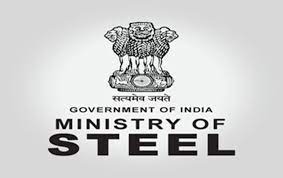
The National Metallurgist Award 2021 will be hosted by the Union Ministry for Steel. Ram Chandra Prasad Singh, the Union Minister of Steel will be chairing this program.
- The National Metallurgist Award has been instituted by the Ministry of Steel after extensive deliberation with the Ministry of Home Affairs (MHA).
- The submissions of applications for the award were initiated from August to September 2021.
- The applications were then screened by the Screening and Selection Committees and the awardees were finalized.
- The awards are given in the categories of National Metallurgist Award, Lifetime Achievement Award, Young Metallurgist (Metal Science) Award, and the Award for R&D in the Iron & Steel Sector.
National Metallurgist Day Award
- Earlier the name of the award was National Metallurgist Day Award. It was changed later.
- The eligibility conditions of the National Metallurgist Award have been made less restrictive to increase the nomination pool and the number of awards has also been reduced to enhance the award’s stature and to make it more focused.
National Apprenticeship Mela 2022:
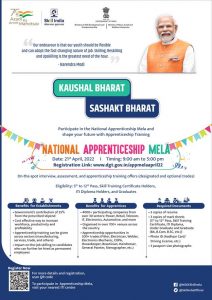
In more than 700 locations the National Apprenticeship Mela 2022 will be organized. This event is being organized by Skill India in association with the Directorate General of Training.
- The aim of this initiative is to support the hiring of over one lakh apprentices and assist the employers in tapping the right talent from across the country and develop it further with proper training and providing various practical skillsets.
- From more than 30 sectors, over 4000 organizations will be participating in the National Apprenticeship Mela.
- The sectors include retail, power, IT/ITeS, telecom, automotive, electronics, etc. Also, the candidates will be able to select and engage from more than 500 trades that include electrician, welder, beautician, housekeeper, mechanic, etc.
- Students who have completed at least Class 5 and have also completed Class 12 are eligible to apply at this apprenticeship mela.
- Also, ITI students along with the students who are having skill training certificates, graduates, and diploma holders will be able to take part in this event.
The National Conference On Agriculture For Kharif Campaign 2022-23
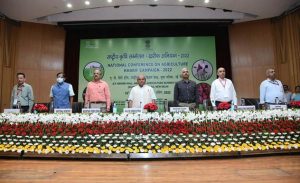
The National Conference on Agriculture for Kharif Campaign 2022-23 has been inaugurated by Union Agriculture Minister, Narendra Singh Tomar at the NASC Complex, New Delhi. As per the 2nd Advance Estimates (2021-22), the country’s total production of foodgrains is estimated at 3160 lakh tonnes which is an all-time record.
- The production of oilseeds and pulses will be 371.5 and 269.5 lakh tonnes, respectively.
- As per the 3rd advanced estimates, during 2020-21 the horticulture production is 3310.5 lakh tonnes, the highest ever for the country’s horticulture.
- This conference’s objective was to assess and review the crop performance during the previous crop seasons and fix crop-wise targets for the Kharif season in consultation with the various State Governments of the country.
- Also, ensuring critical inputs supply and facilitating the adoption of innovative technologies for the enhancement of production and productivity of crops were also talked about.
- Agro-ecological based crop planning is the current priority for the diversion of land from excess commodities like wheat and rice to deficit commodities such as pulses, oilseeds, and high-value crops for export earnings.
- Also, high priority is also being given to crop diversification with the focus on self-sufficiency in Pulses, Oilseeds, Palm Oil, etc.
- To finalize a National Policy Frame Work for Crop Diversification Programme, consultations with researchers, states, policymakers, and industries have also been conducted.
- National targets have also been set by the conference.
- For the year 2022-23, the target for total food grain production has been set at 3280 lakh tonnes as compared to the 3160 lakh tonnes during the current year.
- The target for production of pulses and oilseeds has been fixed at 295.5 and 413.4 lakh tonnes respectively in 2022-23.
- Also, the Nutri-cereals production has to be increased to 205.0 lakh tonnes in 2022-23 from 115.3 in 2021-22.
- In low yielding regions, the strategy would be to increase area through intercropping and crop diversification, while increasing productivity through the introduction of HYVs and the adoption of appropriate agronomic methods.
China Solomon Islands Security Agreement:
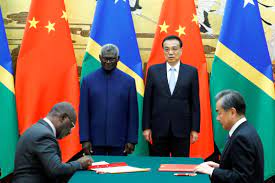
China said it had signed a security pact with the Solomon Islands, a first-of-its-kind arrangement that could pave the way for further Chinese security deals overseas.
- The two sides signed an inter-governmental framework agreement on security cooperation.
- Under the agreement, the two sides “will conduct cooperation in such areas as maintenance of social order, protection of the safety of people’s lives and property, humanitarian assistance and natural disaster response, in an effort to help Solomon Islands strengthen capacity building in safeguarding its own security.”
- Amid concern from Australia, New Zealand and the U.S., the Solomon Islands said there was no agreement for a Chinese military base.
- Solomon Islands is a sovereign country consisting of six major islands and over 900 smaller islands in Oceania, to the east of Papua New Guinea and northwest of Vanuatu.
- Its capital, Honiara, is located on the largest island, Guadalcanal.
Marginal Cost Of Funds-Based Lending Rates Raised:

State Bank of India (SBI) raised the marginal cost of funds-based lending rates (MCLR) for the first time in three years, signalling that the soft rates regime that has prevailed since 2019 may be over.
- SBI raised the MCLR by 10 basis points (bps) across tenures to 7.1% (from 7% earlier); it is now slightly lower than the 7.25% at HDFC Bank, Punjab National Bank, and ICICI Bank.
- MCLR, which RBI instituted with effect from April 1, 2016, is the lowest interest rate that a bank or lender can offer. It is applicable to fresh corporate loans and floating rate loans taken before October 2019.
- RBI then switched to the external benchmark linked lending rate (EBLR) system where lending rate is linked to benchmark rates like repo or Treasury Bill rates.
- As a result of the increase in MCLR, borrowers who have taken home, vehicle, and personal loans will find their equated monthly instalments (EMIs) rising in the coming months.
Alluri Sitaram Raju:
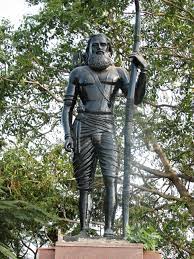
The Vice President, Shri M. Venkaiah Naidu today visited the birthplace of noted freedom fighter and revolutionary, Shri Alluri Sitarama Raju in Pandrangi village near Visakhapatnam, Andhra Pradesh.
- Alluri Sitarama Raju (1897 – 1924) was an Indian revolutionary who waged an armed campaign against British colonial rule in India.
- Born in present-day Andhra Pradesh, he became involved in anti-British activities in response to the 1882 Madras Forest Act, which effectively restricted the free movement of Adivasis (tribal communities) in their forest habitats and prevented them from practicing a traditional form of agriculture known as podu.
- Rising discontent towards the British led to the Rampa Rebellion of 1922, in which he played a major part as a leader.
- He was nicknamed “Manyam Veerudu” (Hero of the Jungle) by local villagers for his heroic exploits.
NATPOLREX-VIII:

Defence Secretary Dr Ajay Kumar inaugurated, on April 19, 2022, the 8th edition of two-day National Level Pollution Response Exercise, ‘NATPOLREX-VIII’, being conducted by Indian Coast Guard (ICG) off Mormugao harbour, Goa.
- The objective of NATPOLREX-VIII is to enhance the preparedness and response capability of all the stakeholders in combating marine spills.
- It aims at validating the procedures and guidelines as contained in the National Oil Spill Disaster Contingency Plan (NOSDCP) at the national and regional levels under the aegis of SACEP MoU to which India is a member state.
- The event is being attended by more than 85 participants from 50 agencies, including 29 observers from 22 friendly foreign countries & International Organisations and two Coast Guard ships from Sri Lanka and Bangladesh.




